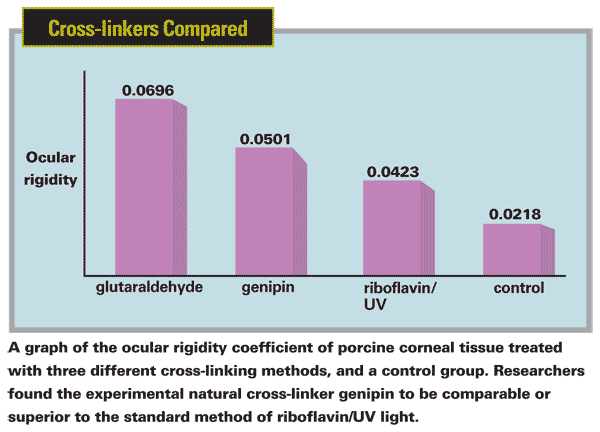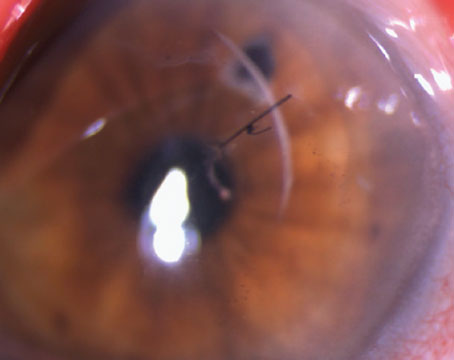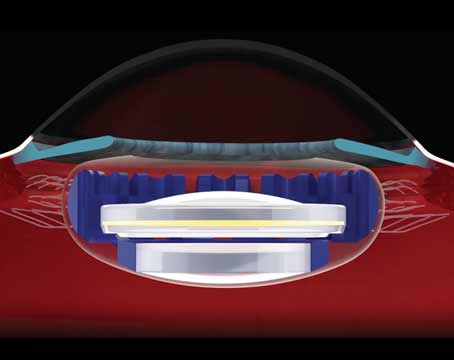In many clinics, corneal cross-linking with riboflavin and UV light is providing very good results in patients with keratoconus and postop corneal ectasia, enabling many of them to avoid corneal transplants. However, questions remain about the possible toxicity involved with exposing the ocular structures to UV light for the period of time necessary to do the treatment. Researchers from
Genipin's Potential
Genipin is a molecule derived from the Gardenia jasminoides plant that research has found has natural cross-linking properties. Its uses have included the cross-linking of cardiac valves and the uncoupling of proteins in the management of type 2 diabetes. 1,2
Marcel Avila, MD, an ophthalmologist from the National University of Colombia, is currently working with genipin in model eyes, and believes the molecule has potential as a cross-linker in the cornea. "In experimental settings, it seems to work with the epithelium on or off," he says. "We apply it for 25 minutes using a Vidaurri Fluid Retention Ring [Katena] at a concentration of 0.25%. That's the concentration at which we can get a good result in terms of increasing the strength of the cornea."
In a study he presented at the most recent meeting of the Association for Research in Vision and Ophthalmology, Dr. Avila compared corneal cross-linking with genipin to that achieved by UV/riboflavin, as well as cross-linking with the powerful but highly toxic glutaraldehyde 0.1%. (
 They found that genipin induced cross-linking comparable to that achieved by UV/riboflavin, including in corneas in which the epithelium was left on. "We're continuing with animal studies now," says Dr. Avila, "and we're analyzing genipin's potential for toxicity to the endothelium, which will be crucial when we consider starting clinical trials in humans for cross-linking. Right now, though, we haven't seen any toxicity in the concentration at which it worked for cross-linking, so that's positive."
They found that genipin induced cross-linking comparable to that achieved by UV/riboflavin, including in corneas in which the epithelium was left on. "We're continuing with animal studies now," says Dr. Avila, "and we're analyzing genipin's potential for toxicity to the endothelium, which will be crucial when we consider starting clinical trials in humans for cross-linking. Right now, though, we haven't seen any toxicity in the concentration at which it worked for cross-linking, so that's positive."
If genipin proves effective for cross-linking in humans, it has the potential to eliminate UV light from the equation, which could have benefits down the road. In a recent paper Dr. Avila published on genipin, he cites research that found UV light induces expression of proto-oncogene in the eye and cornea at dosages of 1.5 J/cm2 and that this dosage has the potential to produce a highly active oxygen species that causes oxidative stress and induces cell death.
3,4 He notes that the dosage necessary for UV/riboflavin cross-linking is five times that: 5.4 J/cm2. Also, UV's effects on cells have been seen in studies of keratocyte damage in model eyes, as well as damage to the lens and retina in animal studies.
5-7 Though it's unclear if such damage will occur to patients cross-linked with UV/riboflavin, Dr. Avila says it might be prudent to avoid the risk by not using UV, if possible. However, there is a benefit to using UV light for cross-linking: It enables the physician to clearly delineate the area to be cross-linked, because it's difficult to limit the treatment to one level of the cornea if you use a chemical cross-linker alone.
8
"There's also an induction of a slight blue color with genipin," adds Dr. Avila. "However, this disappears over time. We have to study it, but in the model it doesn't affect corneal clarity."
Dr. Avila also found that, following cross-linking with any agent, an acute increase in ocular volume resulted in a large increase in intraocular pressure. In the porcine eyes that were cross-linked, as well as non-cross-linked controls, the researchers artificially achieved a pressure of 10 mmHg and then began increasing the ocular volume in 200-µl steps. In genipin eyes with intact epithelium at 200 µl, IOP increased to 17.9 mmHg; without epithelium, it went up to 19 mmHg; vs. controls that increased to 14.7 mmHg. At 400 µl of volume, the IOP of eyes with intact epithelia that were cross-linked with genipin was 29 mmHg. IOP in genipin eyes without an epithelium increased to 31.5 mmHg, while the IOP in controls was just 18.7 mmHg. Dr. Avila says he feels this indicates a need to follow cross-linking patients for IOP changes. "We have to be careful with the optic nerve in these patients," he says. "No one has seen problems with IOP increases in cross-linking patients, though."
John Kanellopoulos, MD, a professor of ophthalmology at New York University School of Medicine and corneal cross-linking researcher, says he'd be interested to see more toxicity results from genipin, as well as how it might perform when instilled within a discrete layer of the cornea. "We create a pocket at 150-µm depth using the femtosecond laser," says Dr. Kanellopoulos. "We then instill the riboflavin there. That way, you get cross-linking in a specific area of the cornea. I'd be interested in seeing genipin possibly used in this way. In a cornea with postopectasia, you open a pocket in the flap interface rather than lifting the entire flap to instill the cross-linker."
Chicago
Future Directions
Dr. Avila says that if genipinis proven to be safe, its use in humans would still pose some challenges. "The biggest problem would be getting the correct amount of time to put the cornea in contact with the genipin to get the effect in the anterior part of the cornea while avoiding entrance into the anterior chamber," he says. "We may need to use a vehicle of some sort to enable it to stay in contact with the cornea in order to bring about the effect. This vehicle may be a liquid, or some kind of gel that would keep it in contact with the cornea longer, make it easier to apply and allow for a more controlled application."
1. Somers P, DeSomer F, Cornelissen M, et al. Genipin blues: An alternative non-toxic crosslinker for heart valves? J Heart Valve Dis 2008;17:682-688.
2. Parton LE, Ye CP, Coppari R, et al. Glucose sensing by POMC neurons regulates glucose homeostasis and is impaired in obesity [letter]. Nature 2007;449:228-232.
3. Schmut O, Faulborn J, Trummer G. Quantification of the cytotoxic effect of UV radiation on conjunctival and corneal cells by the CASY cell-analysis system. An alternative to studies on animals [in German].Ophthalmologe 1999;96:375.
4. Wollensak G, Spoerl E, Reber F, et al. Keratocytecytotoxicity of riboflavin/UVA-treatment in vitro. Eye 2004;18:718-722.
5. Dhaliwal JS, Kaufman SC. Corneal collagen cross-linking: A confocal, electron, and light microscopy study of eye bank corneas. Cornea 2009;28-62-67.
6.
7. Dong X, Lofgren S, Ayala SM, et al. Maximum tolerable dose for avoidance of cataract induced by ultraviolet radiation-B for 18 to 60 week old rats. Exp Eye Res 2005;80:561-566.
8.







